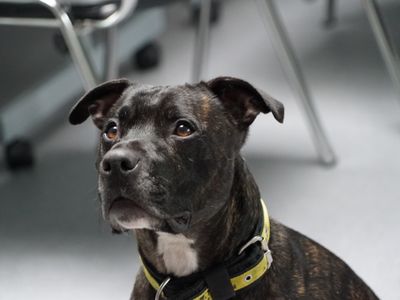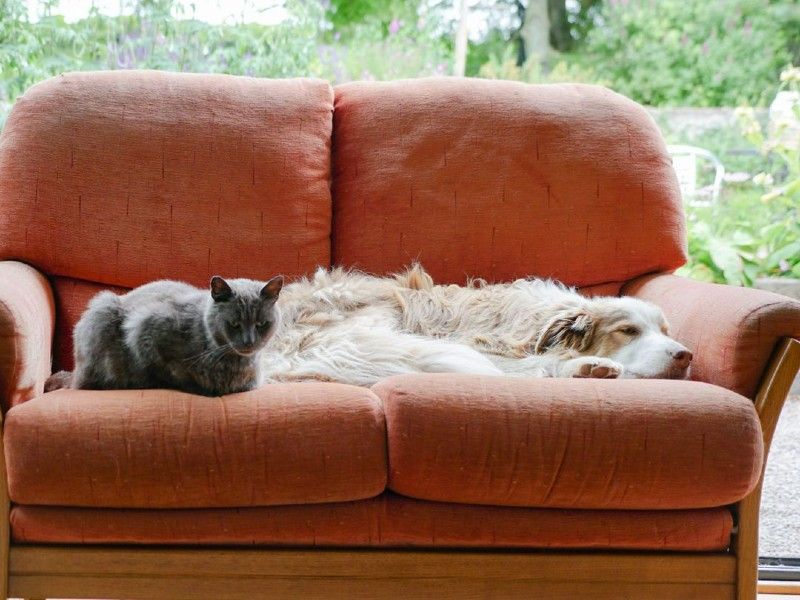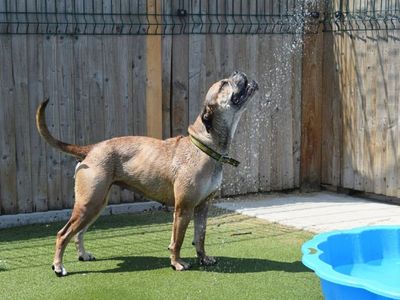
Dogs and cats living together
Here's how to to introduce dogs and cats so they feel comfortable and safe.

Many dogs can live peacefully with cats, often forming a close relationship where they can even sleep together and clean each other. But this is not always the case – not all dogs and cats can live together.
Some cats may be very nervous of dogs, and even a calm dog may scare your cat so much that their welfare is compromised. Likewise, there are some dogs whose predatory drive is so strong they cannot safely be left with cats at all.
If your dog consistently shows signs of being overexcited around cats and can’t be calmed down, it likely isn’t safe for them to live together.
If you find yourself living with a dog and cat who are struggling to be around each other, keep them separate at all times and contact a qualified behaviourist for advice.

Preparing to meet
If you are adding a new cat or dog to your household, then introductions between new and current pets should be gradual and controlled. Here are some top tips to follow before you attempt to introduce your animals to each other.
Scent swapping
Scent is an extremely important form of communication for both dogs and cats. Use it to introduce your pets to each other before you bring your new family member home – here's how.
- Ask for a blanket or toy that smells of your new pet. Place it in the middle of the floor for your resident pet to investigate at their own pace.
- Give the current carer of your new pet a blanket or toy that smells of your existing pet so that they can do the same.
- Then, in the first week or so of bringing your new pet home, you can continue to ‘swap scents’ by exchanging items of bedding. Keep going until there are no signs to suggest that your pets are upset by each other’s scents – such as the cat avoiding the items.
Create individual areas
Set up a core area for each pet where they will feel secure eating, drinking, resting and going to the toilet. Make sure that both can access all of their resources without coming into contact with each other. Make sure that your existing cat or dog is comfortable spending time in their core area before bringing home your new arrival.
Use physical barriers
Make a plan to keep your pets separated with physical barriers, such as baby gates or by keeping doors shut, at least in the short term. Chasing is very rewarding for dogs, so it’s vital that they don’t get to practise this behaviour with cats. Your cat should never be forced into the same room as your dog. They should also have access to escape routes in case they do feel threatened.
Safe introductions
Now you can start gradual introductions, but there are two important things you need to keep in mind when introducing your dog and cat.
Keep your pets separate
Your cat and dog should be kept separate unless you are there to watch them and reward good behaviour.
Even then, it’s a good idea to have a physical barrier between your pets. You could also keep your dog on a lead (or preferably a house-training line) until you are confident that they are calm and relaxed around one another.
Always go at your cat’s pace
Introductions should always be at your cat’s pace as they are smaller and more vulnerable. They should always be able to move away easily if they feel the need.
Never restrain your cat in order to introduce them to your dog. If your cat chooses to approach your dog, keep direct control over your dog and reward them for being calm in the presence of your cat.
Over time, your dog should be able to stay calm and focus on you in the presence of your cat, and your cat should gain confidence in the presence of your dog.
If your dog tries to chase your cat, or is excited by their presence, don’t tell them off. Simply move them further away or out of sight and build up contact more gradually.
If your cat shows threatening behaviour to your dog, even if the dog is calm and you have swapped scents successfully, then keep them separate. Seek the advice of a qualified behaviourist.
Keeping the peace
Once your cat and dog have been successfully introduced, there are lots of things you can do to make their lives as happy as possible and to help them get along.
Maintain a core area for your cat where they can eat, sleep, drink, play and go to the toilet without having to come into contact with your dog.
This includes providing your cat with lots of vertical space so that they can move around without having to pass your dog at ground level. Things like bare shelving or ledges to jump onto work well.
Always reward your dog for calm behaviour around your cat.
Don’t tell your dog off for being inappropriate around your cat. This will only confuse them and may result in a negative association with the cat, which could make their behaviour worse.
If they can’t yet be trusted around your cat, keep them separate or put your dog on a lead to prevent chasing. Continue to train your dog to be calm around your cat, and seek advice if needed.
A tired dog is more likely to be calm around your cat, so make sure you keep your dog mentally and physically stimulated.



